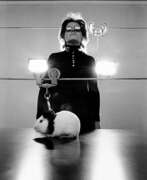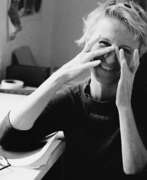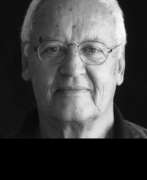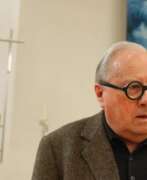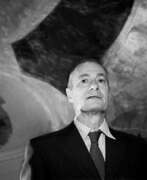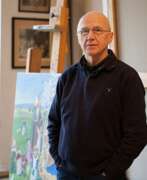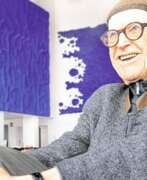Architects 21st century


Vito Acconci was an American artist, designer, and architect. He is best known for his pioneering work in the field of performance art and for his provocative installations that explore the relationship between the human body and space.
Acconci received a Bachelor of Arts degree from Holy Cross College in 1962. He later earned a Master of Fine Arts degree from the University of Iowa.
In the late 1960s and early 1970s, Acconci became known for his groundbreaking performance works, which often involved the artist subjecting his own body to various forms of physical and psychological stress.
In the 1980s and 1990s, Acconci shifted his focus to installation art, creating immersive environments that challenged viewers' perceptions of space and their own bodies. He also worked as a designer and architect, creating public sculptures and buildings around the world.
Acconci's work has been exhibited in major museums and galleries worldwide, including the Museum of Modern Art in New York and the Venice Biennale. He received numerous awards and honors for his contributions to contemporary art, including the Skowhegan Medal for Sculpture in 1995.
His legacy as an influential and provocative artist continues to be felt in the contemporary art world today.


Peter Alexander was an American artist who was part of the Light and Space artistic movement in southern California in the 1960s. He is notable for his resin sculptures from the 1960s and 1970s. He studied architecture in England before receiving both his BFA and MFA from the University of California, Los Angeles. Alexander started as an architect, before developing a reputation in the 1960s for creating his sculptures.


Valery Vladimirovich Androsov (Russian: Валерий Владимирович Андросов) is a Soviet and contemporary Russian artist. He is known as a sculptor, architect, designer, painter, graphic artist and teacher.
Valery Androsov creates landscapes, still lifes and portraits, as well as fantasy works. He is also known as the author of a large collection of ex-libris that accurately convey the character and interests of book owners. At different periods he served as chief artist of the Mosstroiplastmass Combine and director of the Mytishchi Picture Gallery. He also created monuments to those who died in the Great Patriotic War and to the pilots of the Mytishchi Aero Club, showing his skill in various artistic directions.


Ron Arad (Hebrew: רון ארד) is a contemporary Israeli-born artist, architect, and designer known for his innovative and boundary-pushing creations.
Throughout his career, Arad has explored various materials and techniques, embracing both handcrafted and technological processes. His designs often blur the boundaries between art and design, challenging conventional notions of form and function. Arad's furniture pieces are characterized by their sculptural qualities, organic shapes, and a sense of fluidity.


Shusaku Arakawa was a Japanese conceptual artist and architect. He had a personal and artistic partnership with the writer and artist Madeline Gins that spanned more than four decades in which they collaborated on a diverse range of visual mediums, including: painting & printmaking, experimental filmmaking, performance art, and architectural & landscape design.


Gaetana (Gae) Aulenti was an Italian architect and designer who was active in furniture design, graphic design, stage design, lighting design, exhibition and interior design. She was known for her contributions to the design of important museums such as the Musée d'Orsay in Paris (in collaboration with ACT Architecture), the Contemporary Art Gallery at the Centre Pompidou in Paris, the restoration of Palazzo Grassi in Venice, and the Asian Art Museum of San Francisco (in collaboration with HOK Architects). Aulenti was one of only a few women architects and designers who gained notoriety in their own right during the post-war period in Italy, where Italian designers sought to make meaningful connections to production principles, and influenced culture far beyond Italy. This avant-garde design movement blossomed into an entirely new type of architecture and design, one full of imaginary utopias leaving standardization to the past.


Carlo Bartoli is an Italian architect and designer. Author of numerous projects, such as the Gaia chair, included in the permanent design collection of the MoMA in New York and the Milan Triennale Design Museum, and the 4875 chair for Kartell, the world's first made of polypropylene, as well as part of the design collection of the Pompidou Center in Paris.


Mario Bellini is an Italian architect and designer. After graduating from the Polytechnic University of Milan in 1959, Bellini pursued a career as an architect, exhibition designer, product designer, and furniture designer, during the Italian economic boom of the late 20th century. Bellini has received several accolades in a variety of design fields, including eight Compasso d'Oro awards, and the Gold Medal for Lifetime Achievement by the Triennale di Milano. In 2019, the Italian President of the Chamber of Deputies, Roberto Fico, awarded Bellini a career medal, in recognition of his contributions to Italian architecture and design.


Mario Botta, a Swiss architect born in 1943, is celebrated for his profound contributions to contemporary architecture. His work is characterized by a robust geometric style and profound respect for historical context, often integrating modern elements with traditional designs. Botta's designs are known for their distinct use of brick and strong shapes, such as circles, squares, and triangles, which make his buildings instantly recognizable.
Among his notable projects are the San Francisco Museum of Modern Art and the Cathedral of the Resurrection in Evry, France. These structures exemplify his approach to blending new construction technologies with classical forms. The museum, in particular, showcases his ability to manipulate space and light, creating dynamic environments for displaying art. His buildings are not just structures but are often considered sculptural works that enhance their surroundings.
Mario Botta's influence extends beyond architecture into design and education, where he has mentored generations of architects. His work is displayed in numerous exhibitions worldwide and serves as a testament to the enduring power of integrating contemporary design with traditional elements. Collectors and experts in architecture appreciate Botta’s unique ability to transform ordinary spaces into extraordinary places.
For those interested in the innovative work of Mario Botta, consider signing up for updates on new project unveilings and auction events related to his creations. This subscription ensures you stay informed about the latest developments and opportunities to engage with Botta's influential designs.


Michel Boyer was one of the last great interior designers who remained true to the principles of modernity.
Boyer collaborated with Dior, Lanvin, Balmain and designed interiors for hotels, embassies and numerous corporate headquarters. His private clients have included Elie de Rothschild, Liliane Betancourt and Karim Aga Khan.


Alfredo Castañeda was a Mexican surrealist painter.
Castañeda had been interested in painting and drawing since childhood, but first became an architect, earning a degree in architecture from the University of Mexico. During his studies, he continued to paint as a hobby, which he became more and more serious about over the years. At university, Alfredo became acquainted with the painter, sculptor and architect Matthias Goeritz, as well as the work of René Magritte. Both played a huge role in the young artist's worldview.
After his studies, Castañeda worked as an architect and in 1969 had his first solo exhibition at Galeria de Arte Mexicano. His work has also been shown internationally numerous times in the United States and in many Latin American countries, including Mexico. His work is collected in collections and museums throughout the Americas, Europe and Asia.
Alfredo Castañeda is known for his surrealist paintings, often portraits. The same character appears in many of his paintings, sometimes revealed in multiple versions of himself. This person (often resembling the artist himself) seems to be engaged in an endless dialog with himself, involving the viewer as well.


Maurizio Duranti is a contemporary Italian artist, architect and designer. He is engaged in industrial design, designing for numerous companies in all sectors of the home. Duranti is a ten-time winner of the Chicago Good Design Award and was honoured at the Compasso d'Oro in Milan.


Ahmet Ertug is a Turkish architectural photographer and publisher.
He was trained as an architect at the Architectural School of the Architectural Association in London, but developed a passion for photography.
Researching traditional architecture in Japan, Ertug traveled extensively throughout the country and photographed ancient temples, Zen gardens, and traditional festivals. Ertug photographed many of Istanbul's architectural and archaeological structures with Ottoman, Roman and Catholic influences. He founded a publisher of fine art books, and his national fame increased dramatically when he began publishing his photographs in lavish art books. Since then, Ertug's publishing house has published more than 30 such collections. Ertug has also photographed extensively the famous American libraries.


Kurt Fleckenstein is a German artist/sculptor associated with land art, minimal art and installation art. Fleckenstein was born in Heddesheim near Mannheim in Baden-Württemberg. His earlier career in landscape architecture, regional planning and horticultural art led to the establishment of several architectural studios in Germany, Austria and Poland. Since 2003 he has worked as a freelance artist with a focus on spatial objects and installations in exhibition centres and public open space. His provocative art form is designed to charm, irritate and challenge the viewer to question and compare “idealism with realism” on major social, cultural, economic and environmental issues. Fleckenstein now divides his home and work life between Mannheim, Germany and Wroclaw, Poland.


Gianfranco Frattini was an Italian architect and designer. He is a member of the generation that created the Italian design movement in the late 1950s through the 1960s and is considered to have played a major role in shaping it.


Ernst Fuchs was an Austrian painter, draftsman, printmaker, sculptor, architect, stage designer, composer, poet, and one of the founders of the Vienna School of Fantastic Realism. In 1972, he acquired the derelict Otto Wagner Villa in Hütteldorf, which he restored and transformed. The villa was inaugurated as the Ernst Fuchs Museum in 1988.


Julio Galán was a Mexican artist and architect. Galán was one of Latin America's neo-expressionist painters of the end of the last century and the beginning of this one. His paintings and collages are full of elements that usually represent his life.


Nicolás García Uriburu was an Argentine contemporary artist, landscape architect, and ecologist. His work in land art was aimed at raising consciousness about environmental issues such as water pollution.


Dame Zaha Mohammad Hadid, an Iraqi-British architect, was a pioneering figure in architecture, known for her revolutionary designs and as the first woman to receive the prestigious Pritzker Architecture Prize in 2004. Born in Baghdad in 1950, Zaha Hadid's passion for architecture was influenced by her early experiences in Iraq and her studies in mathematics at the American University of Beirut. She further honed her skills at the Architectural Association School of Architecture in London, where she was part of a milieu that challenged traditional architectural norms.
Zaha Hadid's architecture is celebrated for its bold, futuristic forms, often described as being ahead of her time. Her design ethos defied conventional architectural geometry, earning her the nickname "Queen of Curves." Her notable projects include the London Aquatics Centre, the MAXXI Museum in Rome, and the Heydar Aliyev Center in Baku, each characterized by fluidity and innovative spatial concepts.
Zaha Hadid Architects, the firm she founded, continues to push architectural boundaries, reflecting her legacy in numerous global projects, from cultural centers to infrastructural marvels. Despite her passing in 2016, Hadid's influence persists, inspiring a new generation of architects to explore the intersections of design, technology, and art.
For enthusiasts and collectors in art and architecture, Zaha Hadid's work serves as a beacon of innovation and creativity, illustrating the power of architecture to shape experiences and environments. Her contributions to the field have been recognized with numerous awards, solidifying her status as a transformative figure in contemporary architecture.
To stay updated on exhibitions or events related to Zaha Hadid's work, consider subscribing to updates from architectural institutions or galleries that showcase her legacy and ongoing influences in the field.


Christian Heuchel is a German artist, architect, urban planner and professor.
He studied architecture in Karlsruhe and architecture at the Düsseldorf Academy of Art, where he has taught since 2000. Heuchel has been with the O&O Baukunst office since 2000, took over the Cologne office in 2006 and has been a partner of O&O Baukunst Berlin/Cologne/Vienna since 2011.


Herbert Hirche was a German architect, interior and furniture designer and educator.
Hirche studied at the famous Bauhaus school in Dessau and Berlin, where Ludwig Mies van der Rohe and Wassily Kandinsky taught. Trained as a carpenter, he first worked for Mies, Egon Eiermann and Hans Scharun before being appointed professor of applied art at the University of Applied Arts in Berlin-Weißensee in 1948. Four years later he became professor of interior and furniture design at the Stuttgart State Academy of Fine Arts. During his years of teaching, Hirche has educated generations of designers.
In addition to teaching, Hirche designed many homes and interiors. He designed furniture for Walter Knoll, Wilkhahn, Holzäpfel and Wilde+Spieth, as well as several projects for Braun, including the HM5-7 music cabinet and the HF1 television set. Hirche's simple and elegant models were exhibited at various Milan Triennales and the 1958 World Exhibition in Brussels. His work had a great influence on the development of product and interior design in Germany and the world.
Hirche was one of the founders of the Deutscher Werkbund (German Association of Craftsmen) in Berlin, was president of the Verband Deutscher Industrie-Designer (Society of Industrial Designers) for ten years, and was a member of the Rat für Formgebung (German Design Council).
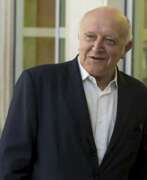

Bertrand Lavier is a French conceptual artist, painter and sculptor, belonging to the post-readymade era, inspired by the Duchampian legacy and the Nouveau réalisme, the artistic movement created by the art critic Pierre Restany in 1960. Lavier studied at the École Nationale Supérieure d'Horticulture in Versailles, France in 1968-1971.


Vico Magistretti was an Italian industrial designer, known as a furniture designer and architect. A collaborator of humanist architect Ernesto Nathan Rogers, one of Magistretti's first projects was the "poetic" round church in the experimental Milan neighborhood of QT8. He later designed mass-produced appliances and furniture for companies such as Cassina S.p.A., and won several awards, including the Gold Medal of the Chartered Society of Industrial Artists & Designers in 1986.


Angelo Mangiarotti was an Italian architect and industrial designer. His designs were mostly for industrial buildings and railway stations. In 1994 he received the Compasso d'Oro award of the Associazione per il Disegno Industriale for his lifetime of achievement.


Roberto Sebastian Antonio Matta Echaurren was a Chilean artist, renowned for his significant contributions to the art world, particularly in painting and sculpture. As a figure deeply embedded in the realms of surrealism and abstract expressionism, Matta's works are celebrated for their complex, otherworldly landscapes and a profound exploration of the subconscious and architecture of the mind. His artistry is marked by fluid, organic forms and a masterful use of color, which set him apart as a visionary in the 20th century.
Matta's influence extended beyond the canvas, impacting the development of both European and American art scenes. His innovative techniques and philosophical inquiries into the nature of reality and human consciousness pushed the boundaries of traditional art forms, making him a pivotal figure among surrealists and later, abstract expressionists. Matta's work is characterized by its evocative, dream-like quality, and his ability to translate psychological concepts into visual spectacles has left a lasting legacy in the art world.
Among his renowned works, Matta's paintings are held in prestigious museums and galleries worldwide, including the Museum of Modern Art in New York and the Tate Modern in London. These institutions house pieces that showcase his unique blend of surrealism and abstract expressionism, offering art lovers and collectors a glimpse into his profound and imaginative universe. For those fascinated by the convergence of culture, art, and psychology, Matta's oeuvre presents an inexhaustible source of exploration and inspiration.
For collectors and experts in art and antiques, the legacy of Roberto Sebastian Antonio Matta Echaurren offers a rich field of discovery and appreciation. His contributions to the realms of painting and sculpture continue to resonate, providing deep insights into the capabilities of artistic expression. To stay informed about new product sales and auction events related to Matta's works, we invite you to sign up for updates. This subscription is your gateway to the latest in the world of this unparalleled artist, ensuring you never miss an opportunity to engage with the art and culture that Matta so vividly represented.


Alessandro Mendini was an Italian designer and architect. He played an important part in the development of Italian, Postmodern, and Radical design. He also worked, aside from his artistic career, for Casabella, Modo and Domus magazines.
The character of his design is marked by what was his strong interest in mixing different cultures and different forms of expression; he created graphics, furniture, interiors, paintings and architecture and also wrote several articles and books. He was renowned as an enthusiastic member of jury in architectural competitions for young designers. He taught at the University of Milan.


Heinrich Neuy is a German artist, furniture designer and architect. His design orientation was shaped by classical modernism. After training as a carpenter, he studied at the Bauhaus in Dessau under Josef Albers, Wassily Kandinsky and the architect Ludwig Mies van der Rohe.
Later, Heinrich Neu developed his own style, characterised by bold colour and abstract composition and dynamic form.


Oscar Ribeiro de Almeida Niemeyer Soares Filho was a Brazilian architect considered to be one of the key figures in the development of modern architecture. Niemeyer was best known for his design of civic buildings for Brasília, a planned city that became Brazil's capital in 1960, as well as his collaboration with other architects on the headquarters of the United Nations in New York. His exploration of the aesthetic possibilities of reinforced concrete was highly influential in the late 20th and early 21st centuries.
Both lauded and criticized for being a "sculptor of monuments", Niemeyer was hailed as a great artist and one of the greatest architects of his generation by his supporters. He said his architecture was strongly influenced by Le Corbusier, but in an interview, assured that this "didn't prevent [his] architecture from going in a different direction".


Katsuhito Nishikawa is a Japanese-German artist, sculptor, designer and architect.
After studying in Japan, he received degrees from the Academy of Fine Arts in Munich and the State Academy of Fine Arts in Düsseldorf. He currently lives and works as a visual artist and furniture designer at Insel Hombroich in Neuss, Germany. Katsuhito Nishikawa is also a visiting professor at the art universities of Hamburg (Germany) and Reims (France).


Driss Ouadahi is an architect and artist originally from Morocco who lives and works in Germany.
He studied at the Hochschule für Beaux-Arts in Algiers and at the Düsseldorf Academy of Art. The abstract architectural forms in Ouadahi's work are surprisingly a response to the buildings of real Algerian houses.
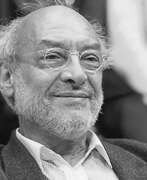

Gaetano Pesce is an Italian architect and a design pioneer of the 20th century. Pesce was born in La Spezia in 1939, and he grew up in Padua and Florence. During his 50-year career, Pesce has worked as an architect, urban planner, and industrial designer. His outlook is considered broad and humanistic, and his work is characterized by an inventive use of color and materials, asserting connections between the individual and society, through art, architecture, and design to reappraise mid-twentieth-century modern life.


Emanuel Pimenta, full name Emanuel Dimas de Melo Pimenta, is a Brazilian-Portuguese musician, architect, photographer and media artist.
In the late 1970s, Pimenta began working in the synthesis of visual arts, music, architecture, media systems, photography and urbanism. He also developed graphic music notation in virtual environments. The results of his research bridging art and science are presented as works in major museums, foundations and art collections in several countries.
Emanuel Pimenta develops music, architecture and urban projects using virtual reality and cyberspace technologies. His music concerts integrate visual art and have been held in different countries over the last twenty years. In 2016, he completed his third opera entitled Metamorphosis. In 2017, Pimenta was awarded the gold medal of the Paris Academy of Arts, Sciences and Letters. Emanuel Pimenta is also a prolific writer: more than eighty of his books have been published since the 1970s.


Giò Pomodoro was an Italian sculptor, printmaker, and stage designer. His brother is the sculptor Arnaldo Pomodoro.
In 1954 he moved to Milan, where he associated with leading avant-garde artists and started making jewelry. He then began to produce reverse reliefs in clay and also formed assemblages of various materials, including wood, textiles, and plaster subsequently cast in metal.
During the 1960s, he developed several series of sculptures, which explored a range of abstract shapes, usually with smooth undulating surfaces. In his later career, Pomodoro regularly received public commissions and produced a number of large outdoor structures.


Boris Mendelevich Rapoport (Russian: Борис Менделевич Рапопорт) was a Soviet and Russian artist of the last third of the twentieth and early twenty-first centuries. He is known as an expressionist painter who worked in the genres of landscape, still life and portraiture.
Boris Rapoport at different periods of his career he worked as an architect and painter. His style reflected the expressionist traditions of the turn of the 19th and 20th centuries with a bias towards romanticism and a personal perception of the world. Since 1992 he has been a freelance artist and his work remains an important contribution to the art of this time.


Horst Rellecke is a German painter and graphic artist, architect and sculptor, living and working in Mönesee.
After studying architecture in the United States and Italy, Rellecke earned his doctorate in engineering in 1982 with a thesis on the relationship between pop music and architecture. His work includes paintings, graphics and sculptures, and he has won numerous architectural competitions and received several awards.
Horst Rellecke's best known work is the landmark of Hammer, a glass elephant he created in 1984 for the first state horticultural exhibition in North Rhine-Westphalia from an old Maximilian coal mine. Drawing and painting still form the basis for all other activities of the artist, such as architecture, the invention of mobile art machines or large laser shows.


Alejandro Ruiz is an Argentine artist, industrial designer, interior architect and educator.
Alejandro Ruiz graduated in industrial design at UNLP in La Plata, Argentina. He has taught classes at the Domus Academy, where he received his Master's degree, and at the Faculty of Architecture of the Technical University of Milan. At Studioruiz, a company he founded himself, he has worked with various internationally renowned brands.
Alejandro Ruiz has participated in many interior design and architecture events and exhibitions in Italy, France, Finland, Germany, Japan, the Netherlands, England and the USA. In 1994, together with Anna Lombardi, he created the Lessdesign brand, whose aim was to develop industrial projects. The designer has been involved in packaging, interior, store, event and exhibition design at Studioruiz.


Afra and Tobia Scarpa are award winning postmodern Italian architects and designers. Their pieces can be found in museums across the United States and Europe, including collections in MoMA and the Louvre Museum. They have collaborated with companies such as B&B Italia, San Lorenzo Silver, and Knoll International. They have won a number of awards such as the Compasso d'Oro in 1969 to the International Forum Design in 1992. Their design work consists of architecture and everyday household items including, furniture, clothing, interior design, art glass. They focused on the technical and aesthetic possibilities of materials in their designs. The couple was greatly influenced by Tobia’s father, Carlo Scarpa, a Venetian architect and designer.




Phillippe Starck is a French designer of interior and mass-produced consumer products.
Starck was educated at the École Nissim de Camondo in Paris, worked for Adidas before founding his first industrial design company, Starck Product, which he later renamed Ubik and went international. He worked with manufacturers in Italy including Driade, Alessi, Kartell, Dimmer in Austria, Vitra in Switzerland and Disform in Spain. He became known for a wide range of his designs, including interior design, architecture, home furnishings, furniture, boats and other vehicles.
Starck has designed residences, hotels, restaurants and other buildings in Tokyo, in Paris, in New York, in Mexico City and other world cities. He has designed the Xiaomi smartphone, the DIAL GPS tracking bracelet, and other technologies. In 2018, Stark collaborated with Axiom Space to design the interior of the International Space Station's habitation module, and a year later, he presented a chair design created with artificial intelligence.
Based on his principles of "democratic design," Starck focused specifically on creating designs for mass-market products rather than unique units. It is impossible to list all the products on which the tireless worker Phillippe Starck has worked and continues to work, the main goal of which is to improve the lives of as many people as possible, as far as possible.


Sergey Yevgenievich Svyatchenko (Ukr. Сергій Євгенович Святченко) is a Danish artist, architect and photographer of Ukrainian origin. He is a representative of the New Wave.
Sergey Svyatchenko has worked on a number of commercial projects, including collaborations with fashion brands such as Hugo Boss and Comme des Garçons.
In his work, Svyatchenko combines elements of photography, painting and collage to create layered and textured compositions. He often uses found materials such as vintage photographs, postcards and magazines and his work is characterised by the use of bold colours, strong graphic forms and surreal juxtapositions.
Sergey Svyatchenko is also a writer and curator. He has published several books on art and photography and has curated exhibitions of contemporary art in Denmark and Ukraine. He is the founder of the Ukrainian Art Foundation, which aims to promote Ukrainian art and culture internationally.


Pierre Szekely was a Hungarian sculptor, architect and educator. In the 1940s, after surviving the holocaust, Szekely became a resident of France, and eventually became an avante garde architect and international lecturer of art philosophy.


Massimo Vignelli was an Italian designer who worked in a number of areas including packaging, houseware, furniture, public signage, and showroom design. He was the co-founder of Vignelli Associates, with his wife, Lella. His motto was, "If you can design one thing, you can design everything," which the broad range of his work reflects.
Vignelli worked firmly within the modernist tradition. His style stressed simplicity by using basic geometric shapes.
